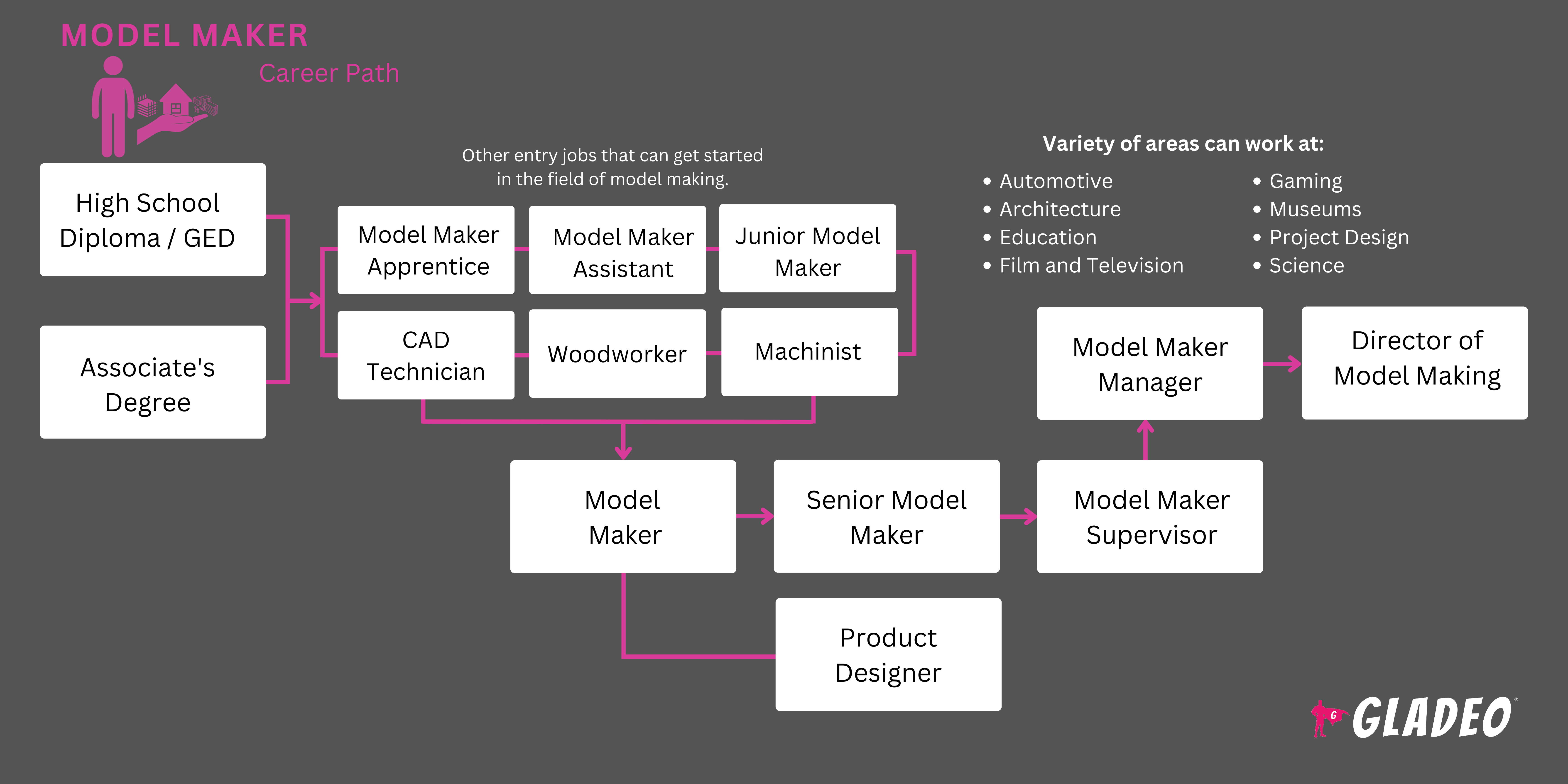Spotlights
Craftsman, Model Builder, Model Maker, Product Development Carpenter, Sample Builder, Sample Maker, Sample Worker, Scale Model Maker, Design Prototype Specialist, Prototype Fabricator
When we think of models, we might picture the small model cars or trains that hobbyists like to assemble. But models serve important functions in several industries such as architecture, automotive engineering, and industrial manufacturing!
In manufacturing, for instance, before a product is ready to be mass-produced and sent to stores, it’s got to be tested out. Part of that process is to build prototypes and mock-ups to demonstrate that the product’s design works in real life. The models are then rigorously checked for quality assurance and consumer friendliness before being approved for production.
These detailed product models are carefully crafted by Model Makers to give stakeholders and testers something they can see, touch, and try for themselves. The models are crucial for providing “proof of concept” – and for revealing any underlying problems that may require finetuning or redesign.
Working closely with designers and engineers, Model Makers ensure their finished models accurately represent the intended design and function within the requested parameters. They use hand tools and operate a wide array of machines to create precision parts out of materials like wood, plastics, and metals. They also incorporate other components, such as internal electronic devices, as needed.
Although it’s a relatively small career field, Model Makers are crucial players in the manufacturing industry. Without their hard work and diligence, we wouldn’t have half the products we use and rely on every day!
- Bringing ideas to life through physical models
- Contributing to product development and innovation
- Opportunities to work with advanced manufacturing technologies
- Collaborating with creative and technical professionals
Lịch làm việc
- Model Makers typically work full-time in workshops, manufacturing facilities, or design studios. Their schedules may have to flex to accommodate deadlines and production cycles.
Nhiệm vụ tiêu biểu
- Examine drawings, blueprints, and technical specifications for proposed models
- Collaborate with engineers and designers to adjust designs, as needed
- Use CAD and CAM software to modify design elements
- Determine dimensions for necessary materials to build models
- Determine the necessary equipment and plan out the sequence of operations
- Program CNC machines to fabricate model parts, or collaborate with CNC machinists or operators
- Điều chỉnh các thành phần máy như lưỡi dao, đồ đạc giữ, v.v.
- Determine which blank types to use to create a workpiece. Verify the tolerance of materials to be machined
- Operate machines such as lathes, saws, presses, etc. to create parts or molds
- Mark guidelines and reference points on materials. Use patterns or other references, as needed
- Use hand tools, files, grinders, sanders, hammers, dies, molds, jigs, and other tools, as needed to shape and smooth workpieces to the required dimensions
- Use power tools to insert holes in parts
- Align and join parts using bolts and screws, or via welding or gluing
- Insert mechanical, electrical, and electronic components into models, ensuring proper wiring and soldering
- Sàng lọc các mục cho các lỗi. Thực hiện điều chỉnh máy móc khi cần thiết
- Sử dụng dụng cụ đo để xác định kích thước của các mảnh chế tạo cuối cùng. Xác minh rằng các sản phẩm hoàn chỉnh tuân thủ các yêu cầu
- Test prototypes for proper functioning
- Rework parts as necessary to ensure they meet standards
- Present models to stakeholders for feedback and approval
Trách nhiệm bổ sung
- Keep track of all details such as materials used, final dimensions of parts, production processes, etc. to ensure standardization for future work
- Maintain and repair tools and equipment
- Mang thiết bị bảo hộ cá nhân cần thiết và tuân theo các quy trình an toàn đã được thiết lập
- Luôn cập nhật các hướng dẫn kỹ thuật và công nghệ mới
- Duy trì tài liệu kỹ thuật và bảng tính dữ liệu
- Train and supervise junior model makers and apprentices
- Participate in product development meetings
- Ensure compliance with safety and environmental regulations
Kỹ năng mềm
- Sự tỉnh táo
- Phân tích
- Chú ý đến chi tiết
- Kỹ năng giao tiếp
- Định hướng tuân thủ
- Sáng tạo
- Tư duy phản biện
- Kỷ luật
- Độc lập
- Quan sát
- Tổ chức
- Kiên nhẫn
- Kế hoạch
- Giải quyết vấn đề
- Stamina
- Làm việc theo nhóm
- Quản lý thời gian
Kỹ năng kỹ thuật
- Computer-aided manufacturing software like Autodesk Fusion 360, SOLIDWORKS, Solid Edge, Siemens NX CAM, GibbsCAM, Mastercam, etc.
- Computer-aided design programs like Autodesk AutoCAD, CATIA, PTC Creo Parametric, and SolidCAM
- Computer numerical control (CNC) machining
- 3D printing programs
- Knowledge of various materials and their properties
- Hand tool proficiency
- Đọc bản thiết kế
- Basic electronics
- Welding and soldering
- Các công ty sản xuất
- Công ty thiết kế
- Công ty kiến trúc
- Film and entertainment studios
- Prototype development firms
- Cơ sở giáo dục
Model Makers are expected to produce highly accurate, detailed models within allotted timeframes. This requires expertise, precision, and often long hours to meet project deadlines.
The work can be physically demanding, requiring fine motor skills and attention to safety protocols. But the satisfaction of turning a concept into a tangible, functioning product can be very rewarding!
3D printing and CAD software have revolutionized model making, enabling more intricate models while reducing production time and costs. There’s also an industry shift towards replacing traditional materials with biodegradable or recyclable alternatives. In addition, companies are turning more to eco-friendly processes that reduce waste and energy consumption.
Another trend is the integration of augmented and virtual reality, allowing designers to project digital models into real-world environments or become immersed in a 3D space for real-time interaction. To some extent, these new technologies are actually reducing the need for physical model-making, but they’re also making it much easier to collaborate on projects remotely.
Model Makers are very hands-on people who might have enjoyed creating things from a young age. They likely spent hours on hobbies such as model building, woodworking, or crafting. Many grew up with a natural curiosity about how things are made!
- The educational requirements to become a Model Maker aren’t set in stone
- Some get started with a bit of vocational training or a certificate. Others may pursue an associate degree or even a bachelor’s degree in industrial design, manufacturing technology, or a related field
- Common course subjects include:
- 3D printing
- Đọc bản thiết kế
- Lập trình CAM và G-code
- CNC machining
- Thiết kế hỗ trợ máy tính
- Đo lường kích thước
- Manufacturing processes
- Material science
- Toán học (giải tích, lượng giác, đại số tuyến tính, hình học, thống kê)
- Mechanical drafting
- Ứng dụng phay và lập trình
- Prototyping techniques
- An toàn cửa hàng
- Hàn và nối kim loại
- Many Model Makers learn through practical experience via internships, apprenticeships, or related jobs
- Students can learn a lot from online courses such as Autodesk’s 19-hour Intro to CAD, CAM, and Practical CNC Machining offered via Coursera. There’s also a four-month Autodesk CAD/CAM for Manufacturing Specialization which includes a hands-on project!
- Familiarity with augmented reality (AR) and virtual reality (VR) tools can enhance a Model Maker’s capabilities and career prospects
- Model Makers don’t usually need a four-year degree but often take classes related to CAD, CNC machining, industrial design, manufacturing technology, or related fields.
- Look for programs with well-equipped, modernized workshops where you can get practical hands-on experience and learn about the latest technologies.
- Programs should have seasoned faculty members and, ideally, opportunities for internships or cooperative learning with local employers.
- Hãy cân nhắc đến chi phí học phí, các khoản giảm giá và cơ hội học bổng địa phương (ngoài viện trợ của liên bang).
- Think about your schedule and flexibility when deciding whether to enroll in an on-campus, online, or hybrid program. Some courses may be better done in person to get hands-on experience.
- Also consider programs that can train you on using AR and VR tools in relation to model making!
- Sign up for plenty of math (arithmetic, algebra, geometry, and trigonometry), physics, computer science, materials science, design, art, and shop classes in high school
- Cân nhắc học vẽ cơ học và đọc bản thiết kế
- Enroll in a community college or vocational/technical school program to learn about CAD, CAM, CNC machining, 3D printing, welding, virtual reality, and other related topics
- You can also take online courses from Coursera, Udemy, edX, Pluralsight, LinkedIn Learning, etc.
- Có được kinh nghiệm thực tế thông qua các công việc bán thời gian liên quan đến gia công hoặc công việc cửa hàng
- Bắt đầu tạo sơ yếu lý lịch của bạn và thêm vào nó khi bạn học hỏi và tích lũy kinh nghiệm làm việc
- Xem lại trước các tin tuyển dụng để xem các yêu cầu trung bình là gì
- Request to do an informational interview with a working Model Maker
- Lập danh sách các địa chỉ liên hệ của bạn (bao gồm địa chỉ email hoặc số điện thoại), những người có thể đóng vai trò là tài liệu tham khảo công việc trong tương lai
- Study books, online articles, and video tutorials related to model-making
- Join online forums to ask questions and learn from experienced professionals
- Engage with clubs and groups to learn, share, make friends, and grow your network
- Build a portfolio of projects to showcase your skills

- Check out job portals such as Indeed, Simply Hired, Glassdoor, and Craigslist
- Có được càng nhiều kinh nghiệm làm việc tại cửa hàng thực tế càng tốt trước khi nộp đơn
- Consider enlisting in the military in a machinist career field. You’ll get free paid training and can earn job experience that can be used in a civilian career, too
- Seek out apprenticeships sponsored by employers, unions, or trade associations
- Ask a working Model Maker for job-seeking tips
- Cân nhắc nhận chứng chỉ hoặc bằng cao đẳng. Chứng chỉ học tập có thể giúp bạn nổi bật so với đối thủ cạnh tranh
- Hãy hỏi trung tâm nghề nghiệp của trường bạn để được trợ giúp kết nối với các nhà tuyển dụng và hội chợ việc làm
- Hỏi trước các tài liệu tham khảo tiềm năng để xem họ sẽ giới thiệu bạn hay viết thư giới thiệu
- Check out online Model Maker resume templates and review potential job interview questions
- Before going into an interview, brush up on the latest news about the field. Be ready to discuss your insights about relevant trends and changes
- Nghiên cứu nhà sản xuất và hướng dẫn phần mềm. Trở thành chuyên gia về các chương trình và máy móc bạn sử dụng
- Ask your supervisor how you can improve your CAD, CAM, and CNC machine knowledge and skills to better serve the company
- Knock out specialized certifications related to cutting-edge technologies like AR and VR
- Demonstrate that you can work independently and collaborate effectively on teams
- Train new workers patiently and thoroughly. Make sure to always wear appropriate personal protective equipment to avoid mishaps and hazards
- Write “how-to” articles to establish yourself as an industry leader
- Branch out into different types of model-making to expand your horizons
- Consider relocating if needed to advance your career!
Trang web
- Tối đa 3Ds
- Viện Kiến trúc sư Hoa Kỳ
- Hiệp hội các nhà xây dựng khuôn mẫu Hoa Kỳ
- Hiệp hội Công nghệ Sản xuất
- Hiệp hội kỹ sư năng lượng
- Association of Professional Model Makers
- Tự động CAD
- Autodesk Fusion 360
- Nhà phát minh Autodesk
- Blender
- CATIA
- Fabricators and Manufacturers Association
- G2.com
- LấyCAD
- TƯỞNG TƯỢNGiT
- Industrial Designers Society of America
- Hiệp hội thợ máy và công nhân hàng không vũ trụ quốc tế
- Hội đồng quốc tế về bôi trơn máy móc
- Hiệp hội năng lượng chất lỏng quốc tế
- Liên minh quốc tế, United Automobile, Aerospace và Nông nghiệp thực hiện công nhân của Mỹ
- Make:
- Manufacturing.gov
- Viện sản xuất
- Viện Kỹ năng Gia công Kim loại Quốc gia
- Hiệp hội gia công và dụng cụ quốc gia
- NX - Unigraphics
- Hiệp hội sản phẩm gia công chính xác
- Hiệp hội tạo hình kim loại chính xác
- Revit
- Shapeways
- Phác thảo
- Hiệp hội kỹ sư sản xuất
- Cạnh rắn
- SOLIDWORKS
- TCT Magazine
- TITANS of CNC Machining
- Công nhân thép thống nhất
- Thống nhất 3D
Sách vở
- Making Things Move DIY Mechanisms for Inventors, Hobbyists, and Artists, by Dustyn Roberts
- Prototyping: A Practitioner’s Guide, by Todd Zaki Warfel
- Rapid Prototyping: Principles and Applications, by Chua Chee Kai and Leong Kah Fai
Model Makers are key players in the manufacturing industry. But the career field is relatively small, and may not be suitable for everyone, so check out our list of related occupations below for additional career ideas!
- Architectural Drafter
- CAD Technician
- CNC Programmer
- Electrical and Electronic Equipment Assembler
- Engine Assembler
- Nhà thiết kế công nghiệp
- Cơ khí máy móc công nghiệp
- Machinist
- Kỹ sư sản xuất
- Kỹ sư cơ khí
- Patternmaker
- Product Designer
- Prototype Technician
- Set and Exhibit Designer
- Structural Metal Fabricator
- Công cụ và Die Maker
Nguồn cấp tin tức

Việc làm nổi bật

Các khóa học và công cụ trực tuyến








